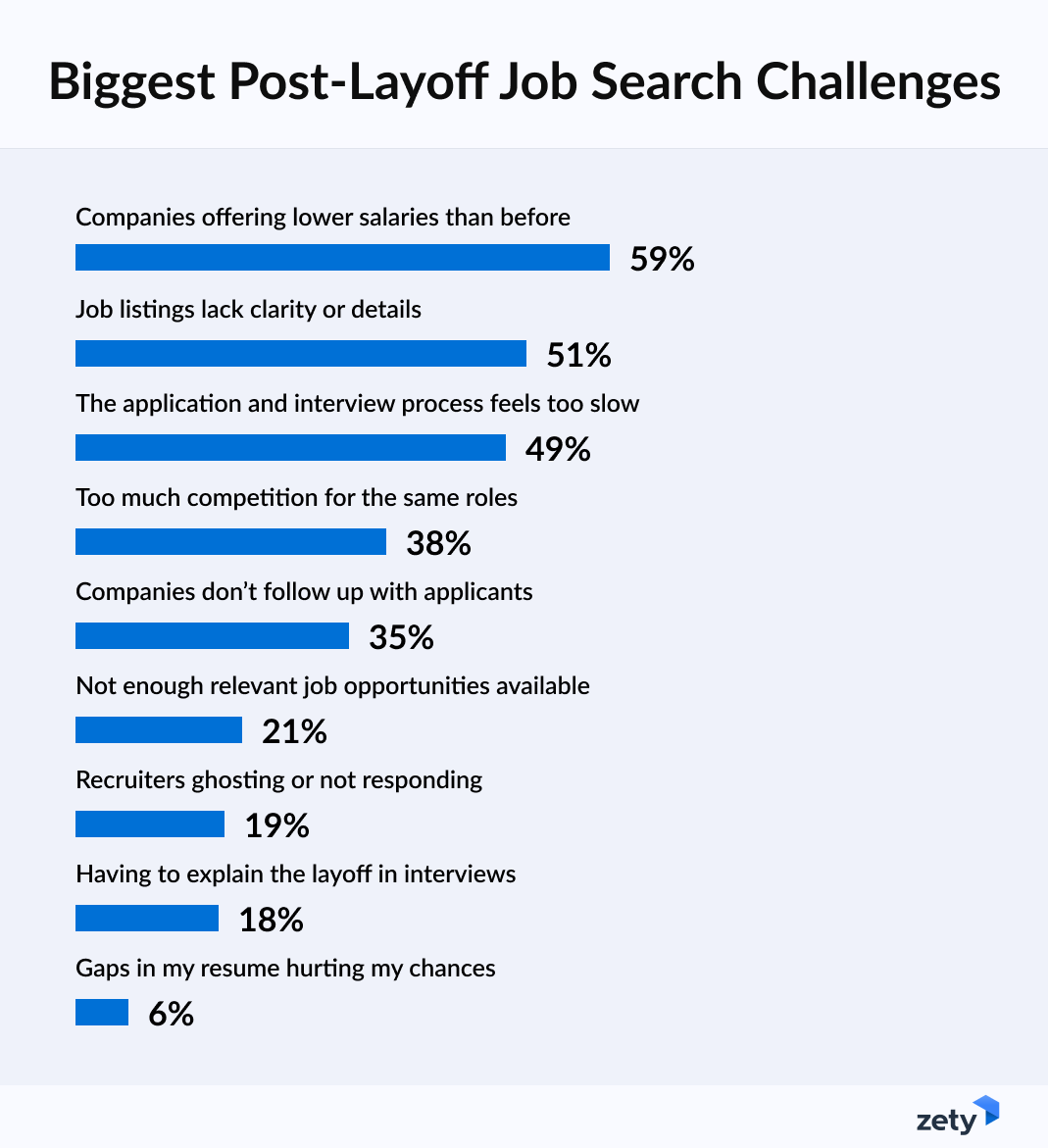
Losing a job can be a life-altering moment, but what happens after the dust settles? To understand how workers are navigating the path forward, Zety surveyed nearly 1,000 Americans who were laid off in the past two years and have since landed new roles.
The 2025 Post-Layoff Recovery Report outlines how recently laid-off workers navigated the job market, including how many applications they submitted, how long it took to find work, what financial resources they relied on, and the most common challenges they encountered in the hiring process.
Key findings:
- Job hunting after a layoff takes persistence: 53% of laid-off workers submitted more than 50 applications before landing a new role, and 1 in 5 had to send out over 100.
- Job search hurdles: Facing lower salaries (59%) was the top challenge of finding a new job.
- Urgency drives action: More than 1 in 3 laid-off professionals began looking for work right away, and 76% were actively searching within the first 30 days.
- Lengthy process: Over 30% were unemployed for more than 90 days, and 5% remained jobless for over a year.
- Career transitions were rare: The majority of job seekers (85%) returned to familiar ground, taking new roles in the same industry.
- Aid beyond unemployment: Nearly 1 in 10 (9%) relied on other government aid like SNAP after being laid off, a safety net now threatened by cuts in the "One Big Beautiful Bill Act."
Job Search Frustrations Run Deep
Respondents pointed to a range of obstacles that slowed or complicated their job search efforts:
- Companies offering lower salaries than before (59%)
- Job listings lack clarity or details (51%)
- The application and interview process feels too slow (49%)
- Too much competition for the same roles (38%)
- Companies don’t follow up with applicants (35%)
- Not enough relevant job opportunities available (21%)
- Recruiters ghosting or not responding (19%)
- Having to explain the layoff in interviews (18%)
- Gaps in my resume hurting my chances (6%)
What this means: Beyond the emotional toll of being laid off, job seekers are entering a market where systemic inefficiencies—like vague listings, delayed timelines, and lack of follow-up—create friction at every turn, suggesting a need for more transparent and humane hiring practices.
Announcing Their Layoffs and Taking Action
Most laid-off workers were open about their experience, with 90% sharing their layoff news publicly on LinkedIn and beginning their job search soon after being let go:
- 40% began their job search within one month
- 36% started looking for a new job immediately
- 15% waited one to three months before applying for new roles
- 8% started looking for a job more than three months after their layoff
What this means: The willingness to publicly share layoff news marks a shift in workplace culture where openness and vulnerability are becoming strategic tools for visibility, connection, and faster reemployment in an increasingly network-driven job market.
Job Search Strategies After Layoff: Time, Effort, and Outcomes
For many, returning to work after a layoff was a long, uncertain journey, often requiring dozens and dozens of applications, months of waiting, and navigating lingering stigma.
- Industry re-entry: 85% of laid-off workers returned to roles in their previous industry, while 15% made a career change.
- Explaining the layoff: 94% included a cover letter specifically addressing their layoff, underscoring the continued pressure to justify employment gaps.
- Time to rehire:
- 17% found a new job within 1 month
- 45% were hired within 1–3 months
- 26% took 4–6 months
- 7% needed 7–12 months
- 5% remained unemployed for more than a year
In total, over 30% were jobless for more than 90 days.
- Applications sent before hiring:
- 19% submitted fewer than 25 applications
- 28% submitted 25–50
- 33% submitted 51–100
- 16% submitted 101–150
- 3% submitted 151–200
- 1% submitted more than 200
Overall, 53% submitted more than 50 applications before landing a job, and 1 in 5 had to send out over 100.
What this means: Despite rapid shifts in the job market, the average job search time after layoff is a slow, grueling return to employment, highlighting how job mobility often favors the well-connected or well-resourced, not just the qualified.
Financial Survival After a Layoff
Between severance uncertainty, inflation, and prolonged job searches, most laid-off workers relied on a patchwork of resources to get by.
Top sources of financial support:
- Savings account/emergency fund (62%)
- Credit cards or loans (54%)
- Help from family or friends (52%)
- Severance pay (31%)
- Investments (stocks, bonds, etc.) (29%)
- Unemployment benefits (27%)
- Gig work/freelance income (15%)
- Government aid programs (e.g., SNAP) (9%)
- Retirement funds (3%)
Lingering concerns: Even after reemployment, anxiety remains high, with 62% of workers very concerned that a potential recession could impact their new job.
What this means: Layoffs don’t just cost people jobs, they unravel financial stability. The reliance on personal savings, debt, and dwindling safety nets signals how precarious economic security has become, even for employed professionals.
Getting back to work after a layoff isn’t just about landing the next role; it’s a test of financial resilience, emotional stamina, and professional adaptability. While most eventually secured new jobs, the journey was often long and filled with setbacks. As economic uncertainty lingers, these findings offer a critical look at what workers truly face—and what support they need—to recover after being let go.
For press inquiries, contact Skyler Acevedo, Public Relations Specialist, at skyler.acevedo@bold.com.
Methodology
The findings presented were obtained by surveying 997 U.S. employees on April 1 who had been laid off in the last two years. Participants were queried about their layoff experiences, responding to various question types, including yes/no questions, scale-based questions gauging agreement levels, and questions that permitted the selection of multiple options from a list of answers.
About Zety
Zety resume templates and Zety's Resume and Cover Letter Generator are trusted by 12 million users each year. With 100s of options to choose from, including professionally designed resume templates to beat the ATS, users can create a professional resume in less than 15 minutes. Since 2016, Zety’s career blog has provided free data-driven insights to over 40 million readers annually, empowering professionals at every stage. The editorial team includes Certified Professional Resume Writers, with the best career advice and evidence-based findings featured in Business Insider, CNBC, and Forbes, among others. Follow Zety on Facebook, LinkedIn, YouTube, X, and Instagram for free expert career tips and updates.


